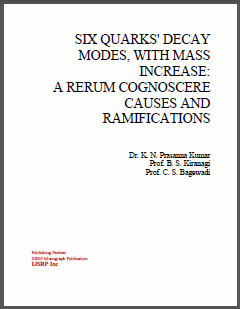
Title:
SIX QUARKS' DECAY MODES, WITH MASS INCREASE: A RERUM COGNOSCERE CAUSES AND RAMIFICATIONS
Authors:
Dr. K. N. Prasanna Kumar, Prof. B. S. Kiranagi, Prof. C. S. Bagewadi
PREFACE
Comprehensive envelope of expression, abstract problematic structures, and functional topology of Super symmetric QCD corrections to the top quark decay of a heavy charged Higgs boson have been done by some authors like Ricardo A. Jiménez, Joan Solà. The super symmetric QCD corrections to the hadronic width of a heavy charged Higgs boson, basically dominated by the top-quark decay mode , are evaluated at O(αs) within the MSSM and compared with the standard QCD corrections. The study of such quantum effects, which turn out to be rather large, is essential to understand the hypothetical super symmetric nature of a heavy charged Higgs boson potentially produced in the near future at the Tevatron and/or at the LHC. It is true that there has been some identarian instances of semantic and experimental jugglery in so far as QCD corrections to the top quark decay mode t-->t~χ0: (Djouadi, A.; Hollik, W.; Jünger, C.Physical Review D (Particles and Fields), Volume 54, Issue 9, 1 November 1996, pp.5629-5635) and impassibility of characteristics and ramified resonations thereof is concerned. Imprisoned complementarities’, survigrous eurhythmics’ of super symmetric theories, the top quark can decay into its scalar partner plus a neutralino, with an appreciable rate. Authors like Djouadi et al. Calculate the O (αs) QCD corrections to this decay mode in the minimal super symmetric extension of the standard model. These corrections can be either positive or negative and increase logarithmically with the gluino mass. For gluino masses below 1 TeV, they are at most of the order of ten percent and, therefore, well under control.
In connection with the Flavor-changing top quark decay within the minimal super symmetric standard model G. Couture, C. Hamzaoui, and H. König present the results of the gluino and scalar quark contribution to the flavor-changing top quark decay into a charm quark and a photon, gluon, or a Z0 boson within the minimal super symmetric standard model. We include the mixing of the scalar partners of the left- and right-handed top quark. This mixing has several effects, the most important of which is to greatly enhance the c Z decay mode for large values of the soft SUSY-breaking scalar mass mS and to give rise to GIM-like suppressions in the c γ mode for certain combinations of parameters. Sheldon, Elizabeth E. Jenkins studied A massive charged scalar, such as is present in a two Higgs-doublet electroweak theory, can alter the nature of top-quark decay, ensuring that the top quark would not have been detected at hadron colliders. Box diagrams involving charged-scalar exchange can produce the observed level of B0− 0 mixing, thus relaxing the need for a heavy top quark. Future experiments can readily establish the existence of the charged scalar. Production and decay properties of ultra-heavy quarks (I. BigiStanford Linear Accelerator Center, Stanford University, Stanford, CA 94305, USA Y. Dokshitzer, V. Khoze P. Zerwas have studied strum and drag of the widths of ultra-heavy quarks that can be decay into W, Z or Higgs bosons are discussed. If the lifetimes become much shorter than the typical strong interaction time scale Λ−1QCD ∼ 10−23 s, then open-flavor hadrons and quarkonium bound states cannot be formed any more. Consequences for the jet evolution are investigated.
To read further, download monograph.
|

|

